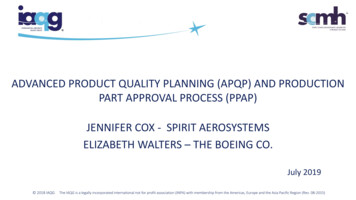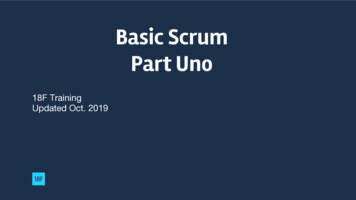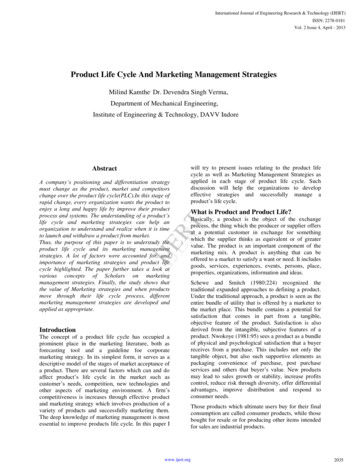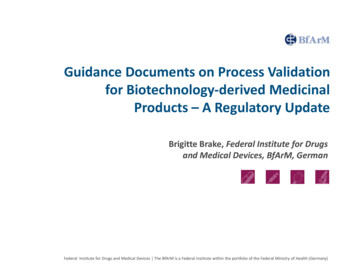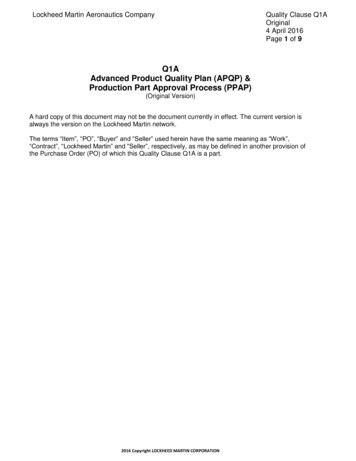
Transcription
Understanding the ProductDevelopment Process of IndividualLife Insurance and Annuity CompaniesLIMRAMarianne Purushotham, FSA, MAAAElaine TumickiRGALeigh AllenFarron BlancDonna Megregian, FSA, MAAAKyle Nobbe, FSA, MAAAHamza ShaibanRevised December 2017Copyright 2017 Society of Actuaries
Sponsoring PartiesSOA Sections Special thanks goes to: Product Development Section Smaller Insurance CompanySection International Section Committee for Life InsuranceResearchPOG Members Carlos Arocha Jan Schuh Ken Birk (POG chair) Ronora Stryker Tim Cardinal Narayan Shankar Anna Dyke John Shaw Andy Ferris Larry Stern Anne Katcher Nancy Winings Ken Lombardo2
Disclaimer The results provided herein come from a variety of life insurance companies with unique product structures,target markets, underwriting philosophies and distribution methods. As such, these results should not bedeemed directly applicable to any particular company or representative of the life insurance industry as awhole. The Society of Actuaries (SOA), RGA Reinsurance Company (RGA), LIMRA, and directors, officers andemployees of each organization disclaim liability for any loss or damage arising or resulting from any error oromission in RGA/LIMRA’s analysis and summary of the survey results or any other information containedherein. This report contains information based on input from companies engaged in the U.S. and Canadian lifeinsurance industry. The information published in this report was developed from actual historical informationand does not include any projected information. The opinions expressed and conclusions reached by the authors are their own and do not represent anyofficial position or opinion of RGA, LIMRA and the SOA or its members. The SOA makes no representationsregarding the accuracy or completeness of the content of this study. It is for informational purposes only. TheSOA does not recommend, encourage or endorse any particular use of the information provided in thisstudy. The study should not be construed as professional or financial advice. The SOA makes nowarranty, express or implied, guarantee or representation whatsoever and assumes no liability orresponsibility in connection with the use or misuse of this study.3
Methodology and Context This research report was primarily conducted via an online survey in thesummer of 2015 through spring 2016, with respondents returning values forthe full calendar year of 2014 Commentary was gained by qualitative interviews with a select group ofrespondents and international in-market product experts at RGA The questions and theses were designed using previous insights fromLIMRA’s 2007 Need for Speed report and RGA’s 2014 International ProductDevelopment Survey Survey respondents collectively wrote premiums* accounting for 29% ofU.S. life insurance, 23% of U.S. annuities and 8% of Canadian life Each section of this report opens with a key highlights page summarizingsome of the subsequent charts and respondent comments*Source: LIMRA’s US Retail Individual Life Insurance Sales 2014, US Individual Annuities 2014, and Canadian Individual Life Insurance Sales 2014reports, respectively4
Executive Summary (1/2) Most respondents adopt a fast follower approach to product design strategy This is at odds with international feedback, whereas most carriers adopt adifferentiation approach to product design strategy Predictive Modeling (PM) is being explored for applicability in underwriting.Currently if it is operationalized, it is for marketing purposes. Internationally PM is used for cross-sell and up-sell campaigns (similar marketing tothe United States) Administration, tracking results vs. plan and product design are the topareas of the product development (PD) process in need of improvement(includes SOA and international survey results) The fastest companies not only move through each stage of the PD processmore quickly than peers but will overlap phases more frequently The fastest companies appear to be more selective when it comes topromoting ideas out of their idea generation phase5
Executive Summary (2/2) Small companies feel they are at a pricing disadvantage because of the costof meeting regulatory requirements Respondents report that 1–3 months is needed to file a product forregulatory approval In many international markets, carriers operate in a launch and file market thatshortens the cycle time New premium and profitability levels are the most common measures ofsuccess Consumer focus groups are more frequently leveraged by the most prolificcompanies Internationally there appears to be more use of agents/advisors to provide feedbackon product designs Brokerage is cited as the channel that has been most frequently added bylife and annuity respondents Internationally bank distribution is more prevalent and as such has a much bigger rolein product design6
Definitions New product: This type of initiative involves bringing to the market significantly new different (to thecompany) product features or functions. A new product would require a unique system identifierand/or would be filed as a new product. Information provided regarding new products should includeall work required to design and implement a new product offering including planning, pricing, newbusiness, administration, commissions, accounting etc. Revision/Enhancement: These initiatives cover the broad spectrum of changes between a rate changeand a new product. The addition of a rider to an existing policy is one example of a revision. Repricing/Rate change: This type of initiative involves modifying or changing rates that are typicallystored in tables or files. Some state filing may be required. Information provided regarding ratechanges should include all work needed to implement a change including planning, pricing and anychange to new business administration, illustrations, testing tools etc. Individual life business: Products issued to an individual insured, and not as a certificate of a group.Excludes group life products such as group term and COLI. Individual annuity business: Products issued to an individual insured, and not as a certificate of agroup. Includes 403(b) business. IIPRC: Interstate Insurance Product Regulation Commission. Also known as the Interstate Compact. MLEA: Multi-Line Exclusive Agents PPGA: Personal Producing General Agent IMO: Independent Marketing Organization7
Definitions Simplified issue: Means you answer a few questions about your medical history forthe life insurance application, rather than undergoing a medical exam Guaranteed issue: Situation where a policy is offered to any eligible applicantwithout regard to health status Low interest rates: Low amount charged, expressed as a percentage of principal, bya lender to a borrower for the use of assets Wellness programs: Include activities such as company-sponsored exercise, weightloss competitions, educational seminars, tobacco-cessation programs and healthscreenings that are designed to help employees eat better, lose weight andimprove their overall physical health Wearable devices: Electronic technologies or computers that are incorporated intoitems of clothing and accessories that can comfortably be worn on the body Underinsured: Gap between the current state and full potential Predictive modeling: Predictive modeling involves “mining” datasets andperforming statistical analysis that may uncover unexpected relationships aboutthe underlying risks that may indicate the likelihood of future outcomes for aninsurer8
Definitions (Based on results of survey) Fastest: Top five companies that completed product development (ideageneration to launch) in the shortest time according to data collected fromSection D of this report Most prolific: Top five companies that completed product development(idea generation to launch) most often, i.e., launched the highest number ofproducts in 2014 from question B3 of this report Most respected: Companies that were chosen by respondents as having themost admired product development according to this report’s data Life only: Companies that answered survey questions only pertaining to itslife insurance PD Annuity only: Companies that answered survey questions only pertaining toits annuity PD Both life and annuity: Companies that answered survey questions pertainingto both life PD and annuity PD (when both is not separated out inresponses, answers for life include life and both; answers for annuity includeannuity and both)9
Specific Question Definitions (section and question number reference) Differentiation-market leader: Distinctiveness in broad market (B2) Differentiation-fast follower: Distinctiveness in broad market (B2) Focused differentiation: Distinctiveness in niche market (B2) Cost leadership: Lowest cost in broad market (B2) Focused cost leadership: Lowest cost in niche market (B2) Cost-driven: The price is set such that the company can cover the costsof creating and selling the product with a reasonable amount of profit(B8) Customer-driven: The price is set such that the company will chargewhatever the customer is willing to pay (B8) Competition-driven: The price is set relative to what competitors arecharging; the price could be slightly more or less (B8)10
Product TypesLife Insurance: Pure [mortality] protection: Term, Term to 100 Nonvariable permanent products: Whole Life, Universal Life, Indexed Universal Life Universal Life with secondary guarantee (ULSG) when the guarantee available can be at least as great as lifeexpectancy or maturity (should not include shorter term guarantees only products) Variable Life products: VULAnnuities: Traditional Fixed Deferred Annuities Indexed Deferred Annuities Single-Premium Immediate Annuities and Contingent Deferred Annuities Variable Deferred Annuities Fixed Indexed AnnuitiesLiving Benefits or Morbidity Rider Products: Insurance products that can be used for individual illness protection,while the policyholder is still alive Disability/waiver of premium/charges Accelerated benefits for chronic illness or critical illness Accelerated/extension of benefits for long-Term care Accidental death benefits11
Product Development ProcessFor purposes of the survey, the following steps in the typical product development process have been defined to provide for consistency in responsesacross participating companies.1)Idea Generation: Ideas for new products or features are reviewed and screened to identify candidates for formal analysis.2)Product Concept and High-Level Feasibility: Business cases or feasibility studies are prepared for each candidate idea. Selected ideas aregrouped into projects and funded.3)Product Planning and Design: Products and features are designed.4)Establish Underwriting Guidelines: Underwriting rules and processes are established, with an appropriate classification of risks.5)Product Pricing: Actuarial pricing that includes setting the rates, reserves, compensation and any other pertinent data. This data are stress testedagainst product profit objectives and expected or actual data.6)Reinsurance : Pricing and treaty negotiation7)Update IT Systems Day 1: Systems requirements are developed and implemented for each gap to cover anything a customer can do Day 1contractually and anything required Day 1 by your organization. This includes illustration systems.8)Update IT Systems Day 2: Systems requirements are developed and implemented for any further functionalities and organizationalrequirements not required Day 1.9)Update Business Procedures: Operations and business procedures are developed for each gap.10)Marketing Plans: Marketing materials and campaigns are developed and executed.11)State Filings: Product forms are drafted and filed. This includes informational product filing (approval not required) to full forms/rates filing.12)Product Launch: Product Development Complete13)Tracking of Results vs. Plan/Business Case: comparing actual business results to pricing/plan to gauge assumptions versus expereince12
Table of ContentsSECTIONSSECTION A: Company InformationSECTION B: Product Development Process and StrategySECTION C: Organization and ResourcesSECTION D: Product Development Steps and TimelinesRight click on link at the leftSelect “open hyperlink” to go to desired sectionSECTION E: Regulation and ComplianceSECTION F: Idea GenerationSECTION G: Product Concept and FeasibilitySECTION H: Distribution Channels and MarketingSECTION I: Expense ApproachesSECTION J: Reviewing and Monitoring Results13
Section ACompany Profile14
Key Section A Highlights Most respondents are from U.S. companies Most respondents come from medium-sized to large companies, with someresults presented based on small companies Respondents collectively wrote 29% of U.S. life insurance, 23% of U.S.annuity and 8% of Canadian life premiums in 2014 according to LIMRA’s U.S.Retail Individual Life Insurance Sales 2014, U.S. Individual Annuities 2014and Canadian Individual Life Insurance Sales 2014 Waiver of premium/accidental death riders are more prevalent on whole lifeproducts in both U.S. and Canada Variable annuity products tend to include death benefit riders UL, VUL and variable annuities have higher prevalence of living benefitriders being attached15
A1:A3 Company ProfileLine and Country of BusinessA1: What is your organization’s corporate structure?23132097117StockOtherAnnuity11Mutual HoldingCompanyMutualFraternalA2/A3: Company Overall Size and FTE EmployeeHead ll company was self-declared rather than making a specific cutoff size31500-999Medium11000-4999Large5000 16
A4: Please provide the following information on new and inforce individuallife/annuity business for calendar year 2014.U.S. Life29% of all U.S. life premium* in 2014New Annual Premium ( M) – Overall 3.8B27% of all U.S. life face amount* in2014New Face Amount ( B) – Overall 424B18% of all U.S. life policies* written in2014New Policies (000s) – Overall 1.6M2621,6718091,333537464Term75358WLULVULInforce Annual Premium ( M) – Overall 32B13,9296920918TermWLULVULInforce Face Amount ( B) – Overall 6.9T25TermWLULVULInforce Policies (000s) – Overall 44TermWLULVUL393Term*Source: LIMRA’s US Retail Individual Life Insurance Sales 2014WLULVUL1,057TermWLULVUL17
A4: Please provide the following information on inforce individual life/annuitybusiness for calendar year 2014.U.S. Life% of Policies with Living Benefit Rider (excl. terminalillness)% of Policies with Waiver of Premium or Accidental ULTermWLULVULWaiver of premium/accidental death showed more prevalence and availability on Whole Life, but the average/medians is 20% of all life policies witheither of these ridersLiving benefits are more popular on UL/VUL, with means and averages less than 15% of policies18
A4: Please provide the following information on new and inforce individuallife/annuity business for calendar year 2014.U.S. Annuity23% of all U.S. annuity premium* in 2014New Premium ( M) – Overall 54BNew Contracts (000s) – Overall riableSPIAFixedIndexedVariableSPIAInforce Contracts (000s) – Overall 4.0MAssets Under Mgmt ( B) – Overall le*Source: LIMRA’s US Individual Annuities 2014SPIAFixedIndexedVariableSPIA19
A4: Please provide the following information on inforce individual life/annuitybusiness for calendar year 2014.U.S. Annuity% of Inforce with Death Benefit Rider% of Inforce with Living Benefit age0%IndexedVariableIndexedVariableOver half of inforce variable annuity contracts in the survey have a death benefit rider; Some have 90–100% of variable annuities with such a rider.Most inforce index/variable annuities do not currently have a living benefits riders, but some companies have over 50% with such a rider.20
A4: Please provide the following information on new and inforce individuallife/annuity business for calendar year 2014.Canada Life8% of all CAN life premium* in 2014New Annual Premium (C M) – Overall 110M5312% of all CAN face amount* in 2014New Face Amount (C B) – Overall 28BNew Policies (000s) – Overall 1.6M66233627211TermWLULInforce Annual Premium (C M) – Overall 1.1B483TermWL154ULInforce Face Amount (C B) – Overall 229B135TermWLULInforce Policies (000s) – Overall m and Term to 100 combined; not enough data to report annuity information for Canada*Source: LIMRA Canadian Individual Life Insurance Sales 201421
A4: Please provide the following information on new and inforce individuallife/annuity business for calendar year 2014.Canada Life% of Policies with Waiver of Premium or Accidental ULSimilar to the U.S., Canadian whole life tends to have more waiver of premium/accidental death than other products.Death benefit and living benefit riders on annuities not applicable in Canada.22
Section BProduct Development Process andStrategy23
Section B Key Highlights Many life and annuity companies are fast followers or focuseddifferentiation, but a noticeable number of companies did not indicatehaving a defined strategy Top reasons for deprioritizing/abandoning products include profitability,resources and administration Although some areas do not have direct authority to abandon/deprioritizeproducts, areas such as IT may be part of a steering committee or decisionmaking group to influence the decision Fastest companies indicate fewer ideas do not make it out of the ideageneration phase Companies rate test marketing and consumer engagement as weaker partsof the product development process Predictive modeling is being explored most in the underwriting space butcurrently used more in the marketing space24
Section B Key Highlights (continued) Administration, tracking plan vs. actual results and product design aretop areas in need of improvement, but less than 30% of companiesindicated improving IT in the last two years Economic conditions have most negative impact on productdevelopment Small companies tend to feel competition more from medium andlarge companies rather than other small companies25
B1. Is product development considered a core competency by SeniorManagement at your 85%82%83%83%No95%67%30%Core competency isfundamental knowledge,ability or expertise in aspecific subject area orskill set that leads to acompetitive tualOtherMutual and Mutual holding companies combined as Mutual; Fraternal combined with Other26
International Survey*: How would you rate your company’s product developmentcapabilities from the following perspectives?For example, company A may see its own PD capabilities as above market average, feels its main competitors see PD capabilities are marketaverage, feel its primary distributor sees its PD capabilities are below average, and the consumer sees PD capabilities are market average.100%3%10%90%80%38%70%60%50%87% ofcompaniessee its PDcapabilitiesat or nternally7%*2014 RGA International PD survey4%6%34%82% ofcompaniesthink its maincompetitorssee its PDcapabilities ator abovemarketaverage3%Main competitor37%2%2%Primary Distributorperception31%77% ofcompaniesthink itsprimarydistributionsee its PDcapabilities ator abovemarketaverage19%Good47%3%7%7%82% ofcompaniesthink its endconsumersee its PDcapabilitiesat or abovemarketaveragePoorperceptionEnd consumerDon't knowFar below market averageBelow market averageMarket averageAbove market averageBest in marketMore companies thought distribution had a less favorable perception of PD capabilities than main competitors or consumers. NoNorth American company thought others saw their PD capabilities as far below market average.27
B2. Which of the following best describes the primary focus of your organization’slife insurance product development strategy? (If your strategy varies by producttype (e.g., UL vs. term), select based on your top-selling product type)Quite a few companies haveno defined strategyStrategy is not definedProlific: AnnuityCost leadershipFastest:AnnuityAnnuityFocused differentiation (niche)Prolific: LifeFastest:LifeDifferentiation - fast followerLifeSmallDifferentiation - market leader01See definitions at beginning of report23456789101128
B2. Which of the following best describes the primary focus of your organization’slife insurance product development strategy? (If your strategy varies by producttype (e.g., UL vs. term), select based on your top-selling product type)Strategy is not definedCost leadershipOther:AnnuityMutual:AnnuityMutual companies had ahigher prevalence of beingfast followersFocused differentiation iation - fast followerStock:LifeDifferentiation - market leader012345678One of the largest drivers for being a fast follower includes the huge expense of innovation (especially around technology, legacy systemsand inflexible processes)Mutual includes Mutual and Mutual holding company.Other includes Fraternal and Other combined.See definitions at beginning of report29
Interview comments on overall product strategy fast following. I think part of it is, to launch brand new in the market, it’svery much test, try, test. It’s sort of that cycle. It comes down to your sizesometimes in that perspective [You] only have so much technologyinnovation budget. I would say it’s not a black and white answer. I’d say we’ve squarely landedin the gray We do research and look at what might be innovative, whatmight work. But at the same time we’ve got to watch what other[s] aredoing. We’re probably a fast follower like a lot of companies. But on the otherhand, we do have some innovative things that we have done It just takesmore money and more time to do things in today’s market environmentthan it took us 10 years ago.30
International responses on product strategyWhich of the following best describes the primary focus ofyour organization’s life insurance PD strategy?*Strategy is not universally definedCost leadership (lowest cost in broad market)Differentiation - fast follower (disctinctiveness inbroad market)Focused differentiation (distinctiveness in nichemarket)Differentiation - market leader (distinctiveness inbroad market)0%10%20%30%* N 31, taken as a mobile straw poll during a gathering in Barcelona, Spain, at the2016 Life Insurance Forum of senior life insurance executives from Europe.40% In Hong Kong, focused differentiation isthe more prevalent strategy. Smallcompanies tend to follow leaders andcreate product niches. In Italy most products sold areinvestment oriented, and companystrategies have changed due to volatilemarket conditions. Thus, companiescannot define a single product strategy. In France, multinational insurers arealways market leaders where nationalcompanies’ strategies focus on lowercost. In Brazil, there is a hyper-focus ofstrategy with little variation oropenness to change due todistribution.31
International Survey*: Approximately how many product launches does yourcompany complete in 1 year?1Insurance productsthat can be used forindividual savings due to their cash valueaccumulation (e.g., UL or Whole Life)100%90%80%70%60%50%40%30%20%10%0%Living Benefit3Risk2Savings19 6-84-51-3None2Insurance productsthat can be used forindividual mortality risk protection due to theirlack of cash value (e.g., Term Life, ULSG,Accident)100%90%80%70%60%50%40%30%20%10%0%9 6-84-51-3None3Insurance productsthat can be used for individualillness protection, while the policyholder is still alive(e.g., Critical Illness, Long Term Care and Disability)100%90%80%70%60%50%40%30%20%10%0%9 6-84-51-3NoneGlobally, companies develop more products outside of North America; possibly due to immature markets and different regulatory regimes.Most North American companies developed 4 products in 2014*2014 RGA International PD survey32
B3. Please provide the following information for U.S. Term Life Products offeredby your company on an individual or retail market basis in 2014.Max 4100%No3%13Rate75%ile 1.7550%ile 197%YesRevision7New780%Min/25%ile 0On trackDeprioritized 3%AbandonedAvg 1.03% companies with productavailable for saleCompleted &launchedTotal efforts 30# of PD effortsstarted in 2014type of effort planned ifstarted in 20147%10%completionstates of2014 effortsNot all companies answered all parts of B3, therefore type of effort will not always equate to total effortsin 201433
B3. Please provide the following information for Canadian Term Life Productsoffered by your company on an individual or retail market basis in 2014.Max 4100%No0%3Rate75%ile 2.550%ile 1.525%ile 0.75100%Yes0On track0%DeprioritizedAbandonedMin 0Avg 1.75% companies with productavailable for sale# of PD effortsstarted in 201486%1RevisionNewCompleted &launchedTotal efforts 7type of effort planned ifstarted in 201414%completionstates of2014 effortsNot all companies answered all parts of B3, therefore type of effort will not always equate to total effortsin 201434
B3. Please provide the following information for Canadian Term to 100 LifeProducts offered by your company on an individual or retail market basis in 2014.100%No0%2RateRevision0New075%ile/max 150%ile 0.5100%Yes# of PD effortsstarted in 2014100%On trackMin/25%ile 0DeprioritizedAbandoned 0%Avg 0.50% companies with productavailable for saleCompleted &launchedTotal efforts 2type of effort planned ifstarted in 2014completionstates of2014 effortsNot all companies answered all parts of B3, therefore type of effort will not always equate to total effortsin 201435
B3. Please provide the following information for U.S. Whole Life Products offeredby your company on an individual or retail market basis in 2014.Max 4100%NoRate16%75%ile 1.7550%ile 184%Yes% companies with productavailable for sale3RevisionTotal efforts 26Completed &launched54%On track23%8New7Min/25%ile 0Deprioritized8%Avg 1.00Abandoned15%# of PD effortsstarted in 2014type of effort planned ifstarted in 2014completionstates of2014 effortsNot all companies answered all parts of B3, therefore type of effort will not always equate to total effortsin 201436
B3. Please provide the following information for Canadian Whole Life Productsoffered by your company on an individual or retail market basis in 2014.Max 4100%No0%Rate75%ile 1.7550%ile 1100%YesRevisionNewCompleted &launched183%0225%ile 0.75On trackDeprioritizedAbandoned 0%Min 0Avg 1.50% companies with productavailable for saleTotal efforts 6# of PD effortsstarted in 2014type of effort planned ifstarted in 201417%completionstates of2014 effortsNot all companies answered all parts of B3, therefore type of effort will not always equate to total effortsin 201437
B3. Please provide the following information for U.S. Universal Life (UL) Productsoffered by your company on an individual or retail market basis in 2014.100%Max 3No7%Rate75%ile 12Revision7YesMin/25%ile/50%ile 0Avg 0.69% companies with productavailable for sale# of PD effortsstarted in 201465%6New93%Completed &launchedTotal efforts 20type of effort planned ifstarted in 2014On s of2014 effortsNot all companies answered all parts of B3, therefore type of effort will not always equate to total effortsin 201438
B3. Please provide the following information for Canadian Universal Life (UL)Products offered by your company on an individual or retail market basis in 2014.Max 5100%No0%Rate75%ile 2100%Yes3Revision1New1Min/25%ile/50%ile 1# of PD effortsstarted in 2014100%On trackDeprioritizedAbandoned 0%Avg 2.00% companies with productavailable for saleCompleted &launchedTotal efforts 8type of effort planned ifstarted in 2014completionstates of2014 effortsNot all companies answered all parts of B3, therefore type of effort will not always equate to total effortsin 201439
B3. Please provide the following information for U.S. UL Secondary GuaranteeProducts offered by your company on an individual or retail market basis in 2014.Max 4100%NoRate632%75%ile 1RevisionNew68%Yes4Min/25%ile/50%ile 0# of PD effortsstarted in 2014Completed &launched78%On track 0%Deprioritized11%Abandoned11%2Avg 0.86% companies with productavailable for saleTotal efforts 18type of effort planned ifstarted in 2014completionstates of2014 effortsNot all companies answered all parts of B3, therefore type of effort will not always equate to total effortsin 201440
B3. Please provide the following information for U.S. Indexed Universal LifeProducts offered by your company on an individual or retail market basis in 2014.Max 4100%NoRate45%50%ile/75%ile 255%Yes2Revision8New925%ile 1AbandonedAvg 1.59# of PD effortsstarted in 2014On track52%30%Deprioritized 0%Min 0% companies with productavailable for saleCompleted &launchedTotal efforts 27type of effort planned ifstarted in 201419%completionstates of2014 effortsNot all companies answered all parts of B3, therefore type of effort will not always equate to total effortsin 201441
B3. Please provide the following information for U.S. Variable Universal LifeProducts offered by your company on an individual or retail market basis in 2014.Max 4100%NoRate32%75%ile 168%YesCompleted &launched1Revision4New4On trackMin/25%ile/50%ile 0DeprioritizedAbandoned 0%Avg 0.76% companies with productavailable for sale# of PD effortsstarted in 2014type of
in product design. 6. Definitions New product : This type of initiative involves bringing to the market significantly new different (to the company) product features or functions. A new product would require a unique system identifier and/or would be filed as a new product. I

